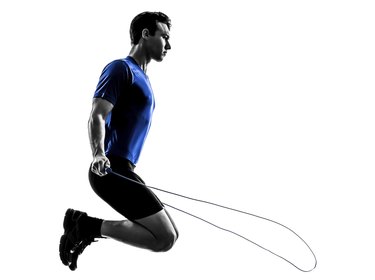
Though it is an effective cardiovascular exercise in itself, jumping rope also provides additional fitness and athletic benefits, including improving your vertical jump. Along with improved coordination and power, jumping rope engages the same muscles that are activated during a vertical leap. If you are trying to add inches to your vertical movement, include jumping rope in your training.
Jumping Muscles
Video of the Day
Jumping rope strengthens your jumping muscles, which are the calves, quadriceps, hamstrings, glutes and abs. Jumping high takes a combination of explosive strength, power and coordination, and it's a compound move. The lower body muscles form a chain that starts with the glutes, travels to the thighs and then down to the calves, the latter of which provides power as the toes are pushing off of the ground. Both jumping rope and vertical jumping activate the lower body in the same manner; the difference is that jumping rope contains an endurance element, while vertical jumping is a single explosive movement.
Video of the Day
Core Strength
Along with maintaining your stability when jumping, your core transfers the power from your lower body to the upper body. As you push off with your toes and propel into the air, the energy travels back up your legs, through the core and up into the upper body as your arms lift over your head to provide momentum. Engaging the core helps to strengthen the core. Jumping rope requires your upper and lower bodies to be active at the same time and the core provides stability, freeing your arms and legs to move in an agile manner.
Vertical Element
Jumping rope helps your body acclimate to vertical movements. Most exercises propel you forward, with occasional backwards and side-to-side movements. Besides climbing stairs, jumping is the main movement that calls for you to work against gravity and travel vertically. Jumping rope, along with other exercises that include a jumping element, such as squat jumps and box jumps, helps to functionally strengthen your legs, core and upper body.
Logistics and Considerations
Include rope jumping in your training sessions two to three days per week to maximize muscle development for verticals. Warm up for the first five minutes of your session by jumping rope at a moderate pace. Build up your endurance gradually if you are a beginner; start with 60 seconds of jumping rope followed by one to two minutes of rest to catch your breath. Increase the jumping duration as you become stronger.